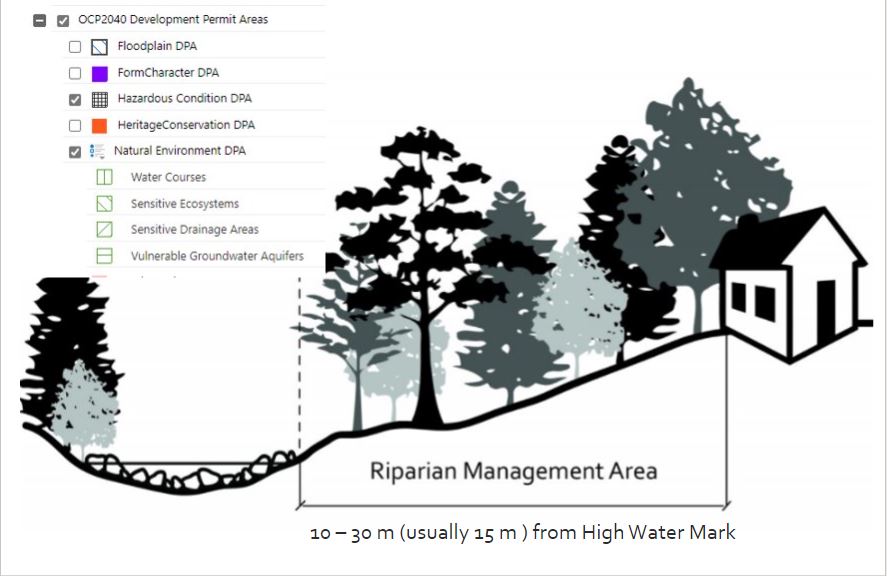Trees & Development
Urban Forests play a major role in supporting the environment through habitat creation and preservation, climate resilience, slope stabilization, and many others. To learn more about the Sustainable Urban Forest Strategy and read the updated 2024 strategy click here.
The City of Kelowna is committed to a context-sensitive tree strategy for development that includes four distinct areas that range between tree protection and restoration objectives: Permanent Growth Boundary (PGB), Hillside Areas, Environmentally Sensitive Areas, and Core Area. We place the most emphasis on protecting forests and large swaths of land beyond the PGB, with the highest consideration for tree preservation and protection. In contrast, within the Core Area where the need for housing and economic growth are key priorities, the emphasis shifts to restoration and new tree planting as part of urban development proposals.
Kelowna's 2040 Official Community Plan (OCP) includes pillars and policies that aim to protect our hillsides, farmland, and rural areas from future growth through a Permanent Growth Boundary. Two pillars of our OCP related to the Permanent Growth Boundary (PGB) are to Stop Planning New Suburban Neighbourhoods and Protect Agriculture, which signals that growth must occur within the growth boundary.
By strategically locating development and density within the Permanent Growth Boundary, we can protect large swaths of environmentally sensitive areas and trees outside the growth boundary. This includes agricultural and rural lands. This demonstrates our commitment to protecting forests and rural lands where we can make the greatest impact on tree preservation. This is the primary branch of the tree strategy for development. To learn more, check out our 2040 OCP Growth Strategies and our OCP Future Land Use Map.
The 2040 OCP establishes Hillside Design Guidelines and Hazardous Condition Development Permit Areas that have slopes exceeding 30%. In these areas, the removal of trees is heavily regulated through Tree Protection Bylaw No. 8041 and the required development permit ensures the protection of large tracts of lands. A Tree Cutting Permit is required for the removal and replacement of trees in these areas if removals are being requested on sites not under development. This aids climate resiliency through protection of forests and groups of trees, or replacement of removed trees if deemed hazardous which aids in slope stabilization. This is the second branch of our tree strategy.
To learn more about a Hazardous Condition or Natural Environment Development Permit check out our page on Environmental Planning. Information about the application process can be found on our Development Application Process page.
The 2040 OCP establishes Environmentally Sensitive Areas mapped as Natural Environment Development Permit Areas around creeks, lakes, and streams between 10 m and 30 m from the high water mark as well as other significant wildlife habitat. In these areas, a development permit is required for any alteration to land or a Tree Cutting Permit is required for the removal and replacement of hazardous trees (regulated through our Tree Protection Bylaw). This is the third branch of our tree strategy.

To learn more about a Hazardous Condition or Natural Environment Development Permit check out our page on Environmental Planning.
Our 2040 OCP has designated Core Area Neighbourhoods and Urban Centres as the areas that will accommodate much of the city’s growth and housing in the upcoming years. This will be achieved through housing infill, townhomes, low-rise and mid-rise apartments, high-density residential development, and commercial and industrial growth. In order to continue to protect lands and forests outside of the Permanent Growth Boundary, it will be necessary to tolerate some loss of trees on private property due to development in urban areas. To mitigate this, we have implemented several initiatives and regulations to promote tree preservation on the small scale and add new trees in strategic locations:
- Landscape Requirements in Zoning Bylaw 12375: The City requires a pre-development tree inventory to highlight trees that could be retained and identify protection measures during construction. In addition, we have robust landscape buffer standards and minimum tree requirements in setback areas which can aid in reducing heat gain in our arid climate.
- Street Trees in Bylaw 7900: When a property redevelops, the owner is required to improve their frontage to current bylaw standards which includes a minimum number of street trees on Public Property.
- Tree Protection Covenant in Tree Protection Bylaw: If a specific tree on private property is able to be retained, we can request that the owner register a Tree Protection Covenant to provide long-term tree protection.
Trees can pose conflicts in an urban setting including reduced site lines for vehicular traffic, interference with overhead electrical lines, root systems damaging underground utilities, necessary road widenings for vehicles and cyclists, and causing damage to trucks on designated truck routes. For this reason, our urban tree strategy primarily focuses on planting new trees in urban locations that are a better fit, getting more trees along frontages for the benefit of the public and the private realm.
The City of Kelowna makes protecting trees in large swaths of forests, hillsides, and environmentally sensitive areas the highest priority where it has the greatest positive impact for forest health. A lower priority is placed on protecting individual trees in an urban environment that is designated to have high levels of growth and development to stop development encroachment into our natural forests.




